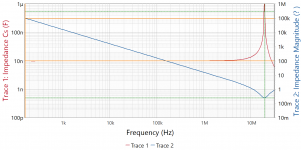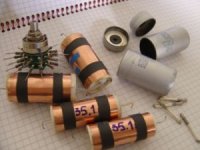Hi everyone,
I built a very nice tube phono stage and I want to try polystyrene capacitors in RIAA correction circuit. As of now I found at farnell capacitors from LCR brand, values required 200pF and 8200pF. Can anyone recommend another source for polystyrene capacitors? I checked ebay for Siemen KS NOS, but couldn't find the values. I also read good things about Reliable Capacitors.
I built a very nice tube phono stage and I want to try polystyrene capacitors in RIAA correction circuit. As of now I found at farnell capacitors from LCR brand, values required 200pF and 8200pF. Can anyone recommend another source for polystyrene capacitors? I checked ebay for Siemen KS NOS, but couldn't find the values. I also read good things about Reliable Capacitors.
I have purchased polystyrene caps from "Surplus Sales of Nebraska" -- https://www.surplussales.com/Capacitors/Poly-Unelco.html
I have purchased polystyrene caps from "Surplus Sales of Nebraska" -- https://www.surplussales.com/Capacitors/Poly-Unelco.html
Me too, I got 0.1dB out of the box from their 2/3% values i.e this batch was much better than spec. They are mostly NOS TRW's and surprisingly cheap.
Hificollective has enough large amounts and variety of polystyrenes.
Polystyrene Capacitors | Hifi Collective
Polystyrene Capacitors | Hifi Collective
Axial polystyrene capacitors are not good for RIAA- too much parasitic inductance .Siemens KS are extended foil, radial low inductance type.
Axial polystyrene capacitors are not good for RIAA- too much parasitic inductance .Siemens KS are extended foil, radial low inductance type.
Here's a 10nF 50V XICON (axial) on the VNA.
Attachments
Here's a 10nF 50V XICON (axial) on the VNA.
Seriously where does this stuff come from.
Seriously where does this stuff come from.
"it sprung forth fully clothed from the mind of Zeus"
Axial polystyrene capacitors are not good for RIAA- too much parasitic inductance .Siemens KS are extended foil, radial low inductance type.
Didn't know that. Looks like the LCR capacitors from Farnell are extended foil as per datasheet. They are axial also.
The Siemens KS are now made by EMZ, and those can also sometimes be found on eBay in certain sizes.
Lots of ways to compare ESL. From f=1/ 2pi SQRT (LC) we can derive the ESL L=1/(4*pi^2*C*f^2).
Attachments
Last edited:
Here's a 10nF 50V XICON (axial) on the VNA.
Puts that myth to rest.. 😀
Didn't know that. Looks like the LCR capacitors from Farnell are extended foil as per datasheet. They are axial also.
And they are just fine, really..
Let me see if I understand your "problem".
These capacitors are ruler flat behaving like perfect textbook examples between 100Hz and 10MEGA Hertz, with a resonance at 15MHz , probably due to lead inductance since it seems to apply equally to all capacitance values, ... and you are agonizing about its response at AUDIO frequencies?
Gimme a break !!!!!!
These capacitors are ruler flat behaving like perfect textbook examples between 100Hz and 10MEGA Hertz, with a resonance at 15MHz , probably due to lead inductance since it seems to apply equally to all capacitance values, ... and you are agonizing about its response at AUDIO frequencies?
Gimme a break !!!!!!
Let me see if I understand your "problem".
The problem with polystyrene is that it melts in the reflow oven!
Other than that, the issue with ESL seems to be a canard or urban myth.
Flancfuster,
Try once russian teflon capacitors in RIAA network.
Open them and unwind to the value you want.
It's worth a try, very much.
I will try that, after all this is what diy is all about 🙂
- Status
- Not open for further replies.
- Home
- Design & Build
- Parts
- Polystyrene capacitors for RIAA circuit


